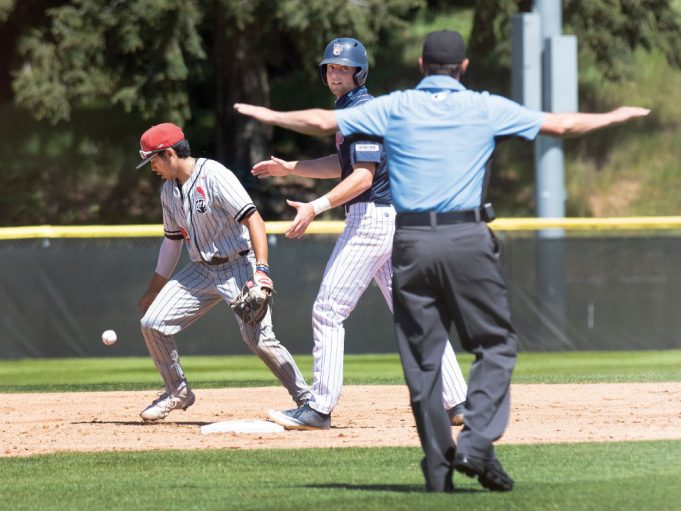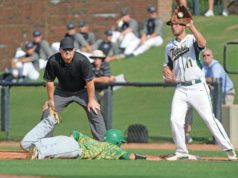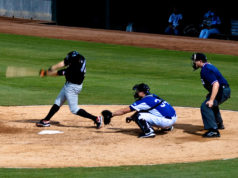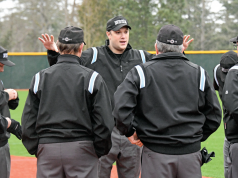Just as we can have rough days on the plate, we can have base games where it seems we’d be better off to flip a coin. We’re all going to have bang-bang plays where we do everything right but freeze-frame video shows we kicked the call; that’s part of being human. But how do we account for misses that are obvious or happen too often?
Timing
Good timing is as essential on the bases as it is on the plate. No matter how experienced we are or how sound our judgment may be, our mind has to have a chance to process what our eyes see. Let the play complete itself and then pause before ruling. When we’re too quick we may, for example, call a runner out because the throw is good when, in fact, he did a hook slide and avoided the tag.
I have no clue why, but throughout my career I was quicker in calling plays at first base and forceouts than I was on tag plays. I had to constantly engage in self-talk to make myself slow down. Not always successfully.
Positioning
Getting a good angle on a play is important. This is one area in which the thinking has evolved over the years. In the old days, for example, umpires from the big leagues on down called plays at the plate from up the third-base line. This left them looking at the runner’s backside, sometimes with disastrous results. In the deciding game of a 1984 NCAA regional, for example, a runner was called safe at the plate for the winning run although video showed he was out by two feet.
In the early ’70s, when I was in the minors, NL umpire Frank Pulli created a stir when he began calling tag plays at the plate from his ball-strike position. This caught on as umpires realized they had a better view with the ball and runner coming into them. Now, umpires start on the third-base line extended and adjust depending on how the throw comes in and how the runner slides.
The same thinking applies to tag plays on the bases. In crews of fewer than four umpires we don’t always have the luxury of making the ball and runner come into us, but if I could I did. If the umpire in the 1984 regional had done this I’m sure he would have made the correct call and after the game the umpires’ dressing-room door wouldn’t have been bombarded by chairs and other debris thrown by the losing team.
The smaller our crew, angles become especially important. In two- and three-umpire crews, there’s no way to get on top of every play, particularly when a play at one base is quickly followed by one at another base. We must accept the fact we’re going to end up some distance away from some plays and try to position ourselves to maximize the chances of seeing all of their pertinent ingredients.
A few words about being on top of plays. People applaud this, but we can get so close that we lose sight of the forest for the trees. Even in four-umpire crews I tried to stay some distance away. As U1, for instance, I set up about 15 feet from the bag as I felt this collapsed my field of vision and gave me a better perspective on the ball and runner’s foot, especially if the fielder had to scoop the ball off the ground. I also stayed back on tag plays unless the runner slid away from the bag and I had to follow the tag.
Be Still
Come to a stop as the crucial part of the play unfolds. Watch video of major league games decades ago and you’ll see umpires calling plays on the run, but now we know we can’t see, and properly register, all of the detail of a play if our eyes are bouncing up and down. Sometimes it’s hard to force yourself to stop when you’re pretty far away from a play, as in a two-umpire crew where you have back-to-back plays at different bases, but you’re better off to get the best angle possible and then stop wherever you are.
Don’t Anticipate
In the 1984 College World Series I was working second base. A runner at first broke early and my mind registered this as an easy out. The pitcher completed his pickoff attempt to the first baseman, who threw to second, but it was high and the fielder had to climb the ladder. By the time he applied the tag, it was on the runner’s upper arm. Because I had my mind made up before the play ended, I didn’t assess it objectively. My mistaken out call snuffed out an important rally.
We set ourselves up to fail if we anticipate how a play will develop, even subconsciously and for a split second. If B1 hits a ground ball in the hole so F6 has to backhand it, we can’t let our first thought be that there’s no way F6 can make the play. That plants a seed in our mind that’s hard to overcome if we suddenly have a whacker because B1 tripped coming out of the box or is just slow. Same thing if B2 hits a ground-ball bullet to F5 so that our mind instantly registers out, but the runner is especially fast and beats the throw by an eyelash.
Making this mistake once caused me to ring up a guy a half-step past first base when the throw got there. When the coach came out to argue I told him I got confused and thought the runner came from the opposite direction. He actually laughed.
Keeping these items in mind should help you to be a good base umpire. And if you boot a call, you’ll be better able to assess why so that you don’t screw up the next one.
Jon Bible, Austin, Texas, worked seven NCAA Division I College World Series. In 2019, he was inducted into the National College Baseball Hall of Fame in Lubbock, Texas. *
What's Your Call? Leave a Comment:
Note: This article is archival in nature. Rules, interpretations, mechanics, philosophies and other information may or may not be correct for the current year.
This article is the copyright of ©Referee Enterprises, Inc., and may not be republished in whole or in part online, in print or in any capacity without expressed written permission from Referee. The article is made available for educational use by individuals.


















